Hatsu Uma Daikondaki
(February 8-11)
A Fiery Celebration of Luck and Tradition in Kyoto
As snow covers the quiet landscape like a blanket, an age-old tradition unfolds in the quiet, sacred grounds of Sanzen-in Temple. Nestled in the misty mountains of Ohara, just outside Kyoto, this temple hosts one of Japan’s most intriguing festivals: the Hatsu Uma Daikondaki Festival.
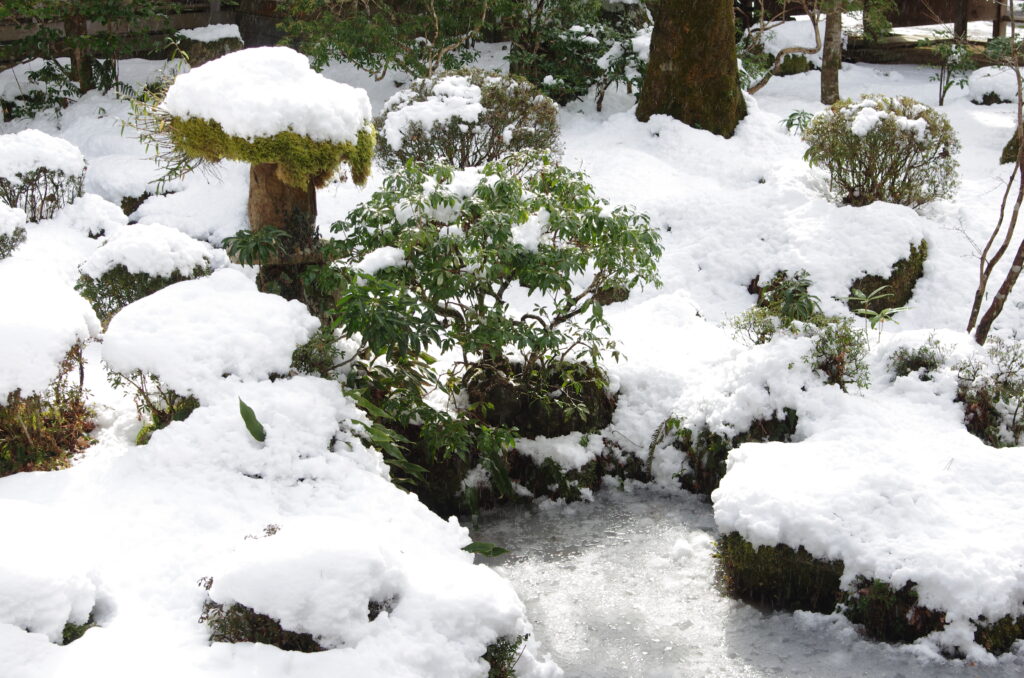
A still winter scene in the garden of Sanzen-in Temple, where delicate layers of snow blanket moss-covered stones and lush greenery.
Every year, on the first “Hatsu Uma” (the first Day of the Horse in the second month of the lunar calendar), this fiery spectacle draws visitors who seek good fortune, purification, and a taste of the simple yet symbolic daikon radish. But what exactly is this festival and why does it center around daikon?
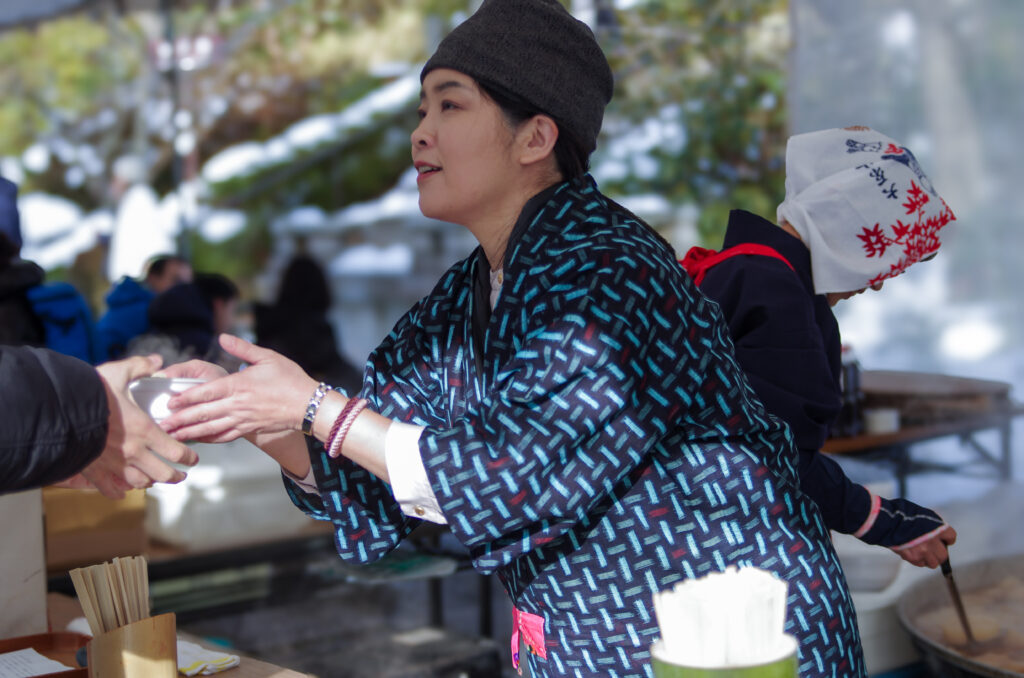
A helper dressed in a traditional indigo-patterned kimono jacket warmly hands a steaming bowl of food to a visitor. Her welcoming expression reflects the hospitality and community spirit of the event. In the background, another volonteer, wearing a headscarf, is seen serving the Radish from a large metal pot.
The Origins of Hatsu Uma and the Tradition of Daikon
The Hatsu Uma tradition traces its roots deep into Japan’s past. It originates from the Shinto belief in Inari, the deity of rice, prosperity and agriculture. According to legend, Inari descended to Earth on the first Day of the Horse in the second month of the lunar calendar. To honor this auspicious event, people began holding rituals to pray for abundant harvests, prosperity, and protection from misfortune. Over time, Buddhist temples like Sanzen-in, founded during the Heian period, absorbed these traditions, creating their own versions of the celebration.
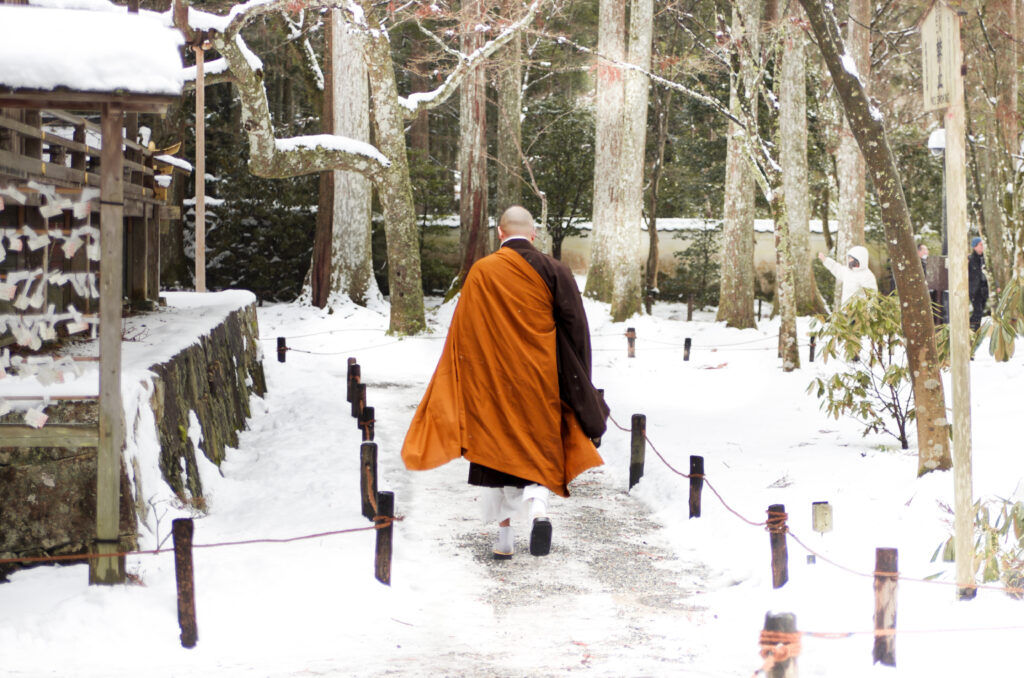
A Buddhist monk walks along a snow-covered path in a tranquil temple setting, his flowing saffron and brown robes providing a striking contrast against the white landscape.
At the heart of the Hatsu Uma Daikondaki Festival is the humble daikon radish. In Buddhist belief, daikon is a powerful symbol of purification, thought to cleanse both body and soul. During the festival, temple monks prepare massive vats of simmering daikon, its gentle aroma mingling with the crisp mountain air. Steaming bowls of tender white radish, lightly seasoned with miso, are offered to visitors. The act of consuming this simple dish is believed to ward off illness and bring good fortune for the coming year.
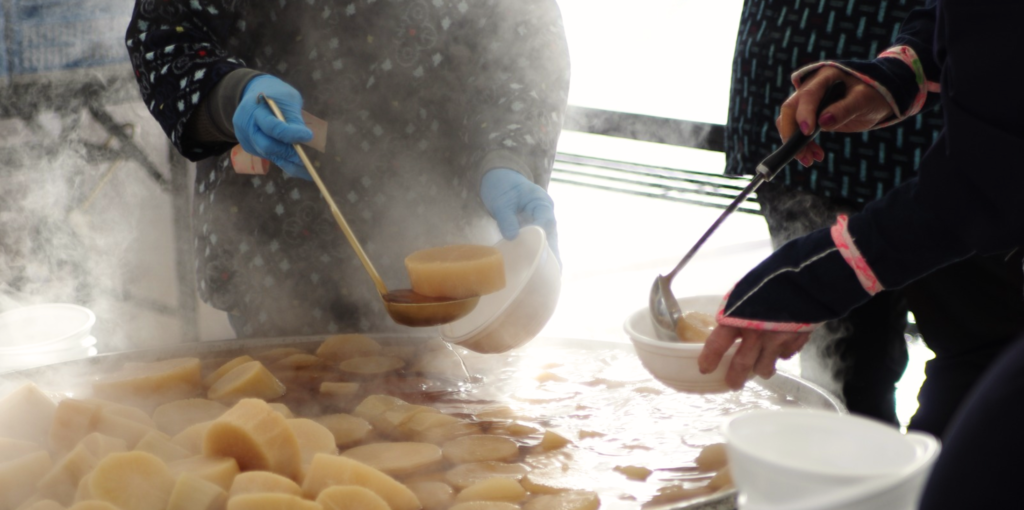
A steaming pot of simmered daikon radish is carefully ladled into bowls, filling the air with steam and rich aroma. Volunteers, dressed in traditional indigo-patterned jackets, serve the comforting dish with care.
Elderly locals tell stories of their grandparents attending the festival, believing that a bowl of daikon here could protect their families from misfortune. Whether one follows the spiritual meaning or simply enjoys the comforting warmth of the dish, there’s an undeniable magic in sharing a meal that has been prepared with centuries of tradition.
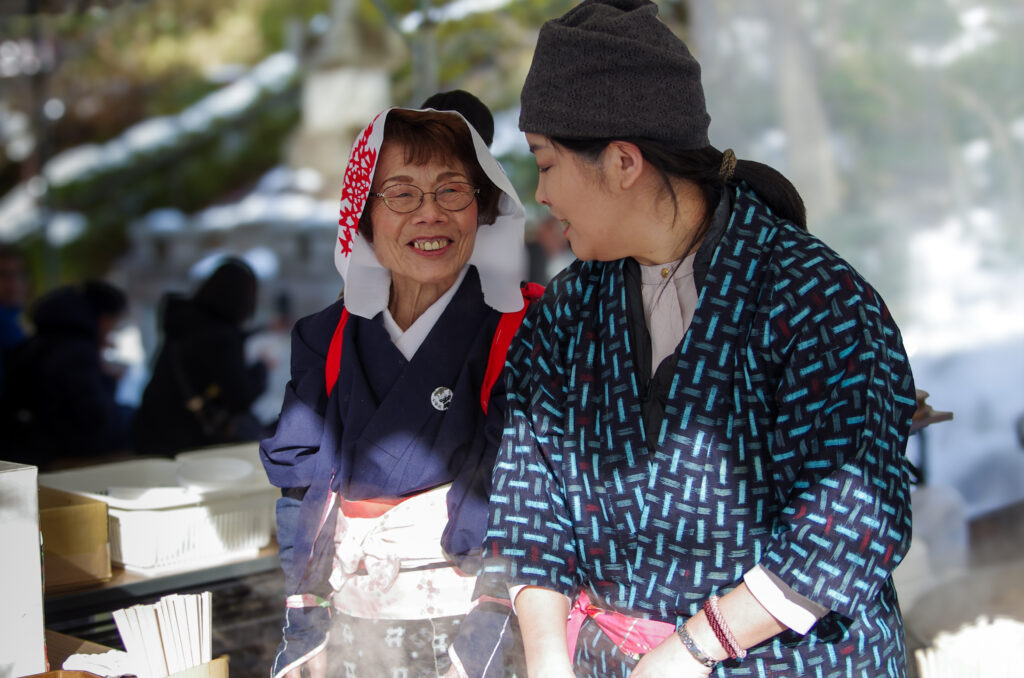
Two women, dressed in traditional Japanese festival attire, share a warm moment while preparing the daikondaki. The elderly woman, wearing a navy kimono and a white headscarf decorated with red maple leaves, smiles brightly. Her younger companion, wearing an indigo-patterned jacket and a gray hat, listens attentively. Behind them, steam rises from the food stall.
A Magical Winter Setting
Unlike the cherry blossom festivals that celebrate the coming of spring, Hatsu Uma Daikondaki takes place in the heart of winter, in 2025 from February 8 to 11. Ohara, where Sanzen-in Temple is nestled, often experiences heavy snowfall during this time, creating a breathtaking winter wonderland. This year, while Kyoto and Osaka may remain untouched by snow, Ohara transforms into a scene of quiet, ethereal beauty, where temple rooftops and towering cedars are blanketed in white. The contrast between the steaming daikon, the warmth of temple fires, and the cold beauty of the surroundings makes for an unforgettable sensory experience.
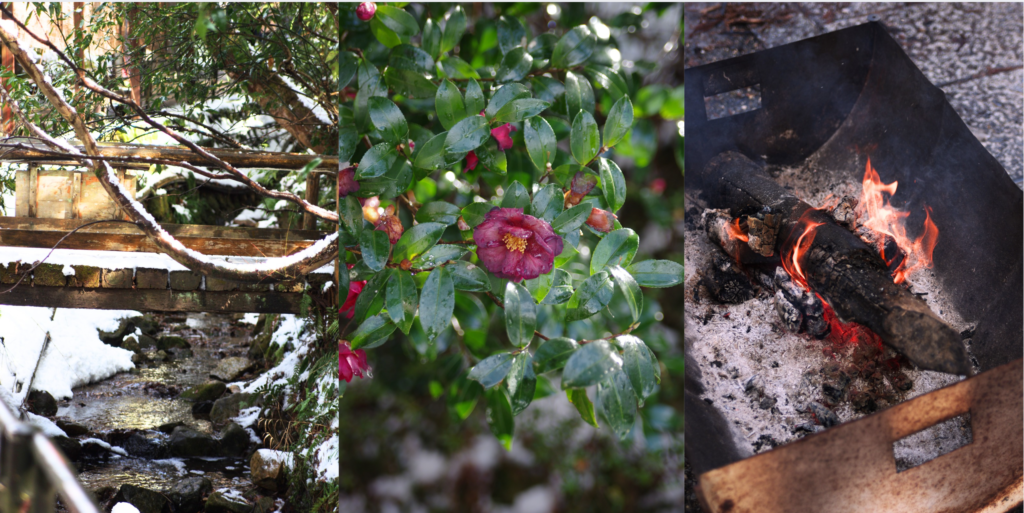
From left to right: A rustic wooden bridge over a gently flowing stream near Sanzen-in in Kyoto, vibrant red Camellia japonica (Tsubaki) flowers with glistening leaves and a crackling fire burning in a metal hearth.
As visitors walk through the charming village, they will pass by beautiful red Camellia japonica (tsubaki) flowers and small wooden bridges with a gentle stream flowing alongside the stone pathways.
The air carries the inviting scents of local delicacies, and small traditional shops line the route, offering a variety of souvenirs. From handcrafted scarves, socks and seasonal spices to warm chestnuts and beautifully wrapped confections, there’s something for everyone. The shopkeepers, known for their kindness and hospitality, greet visitors warmly and let you try their products, making the stroll as delightful as the destination itself. This peaceful village setting adds to the festival experience, allowing guests to immerse themselves in the warmth and friendliness of Ohara before reaching the temple’s sacred grounds.
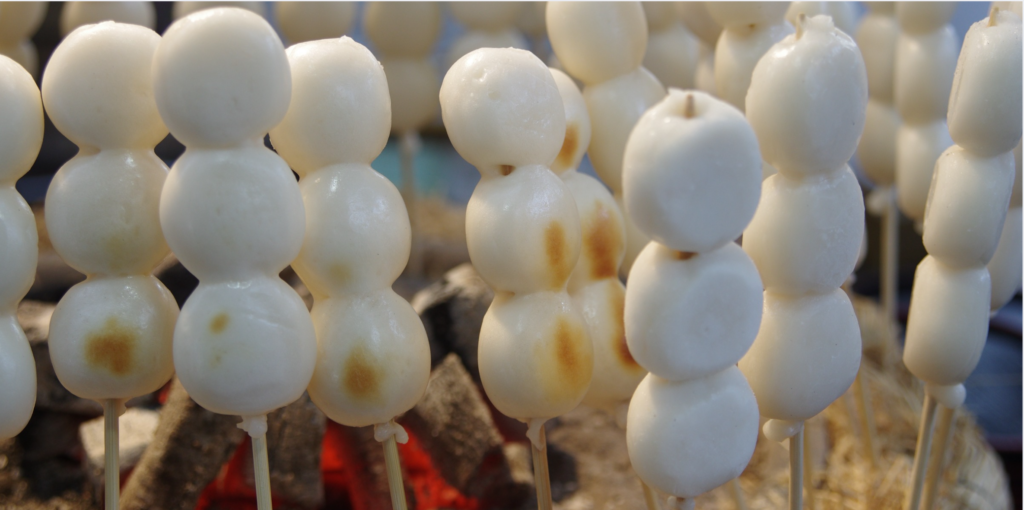
Traditional Japanese rice dumplings (shiratama dango) skewered on sticks and lightly roasted over an open flame, with a golden-brown char forming on their surface.
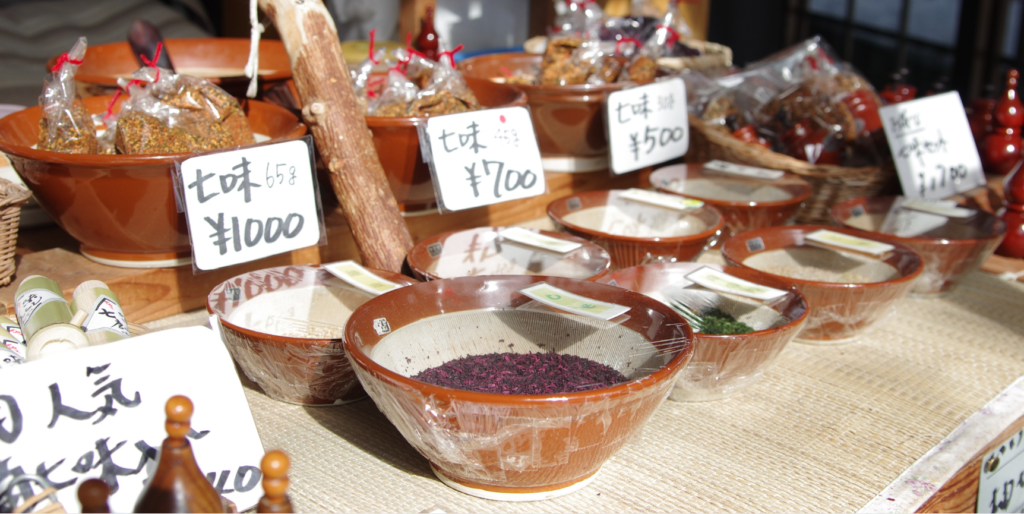
A vibrant market stall along the path to Sanzen-in Temple displays an array of traditional Japanese spices and seasonings including shichimi togarashi (seven-spice blend). The handcrafted bowls and neatly packaged spices reflect the charm of the quaint shopping street where visitors can explore local flavors and artisanal goods before reaching the temple.
Once the Sanzen-in Temple is reached, visitors can experience a moment of tranquility with a traditional Japanese tea setting with matcha and yokan, a smooth and subtly sweet red bean jelly, elegantly served on a red lacquer tray. The tea room overlooks a moss-covered rock garden, where patches of snow add to the seasonal atmosphere. Inside, the wooden architecture and soft natural light from shoji windows create a warm contrast to the crisp winter scenery.
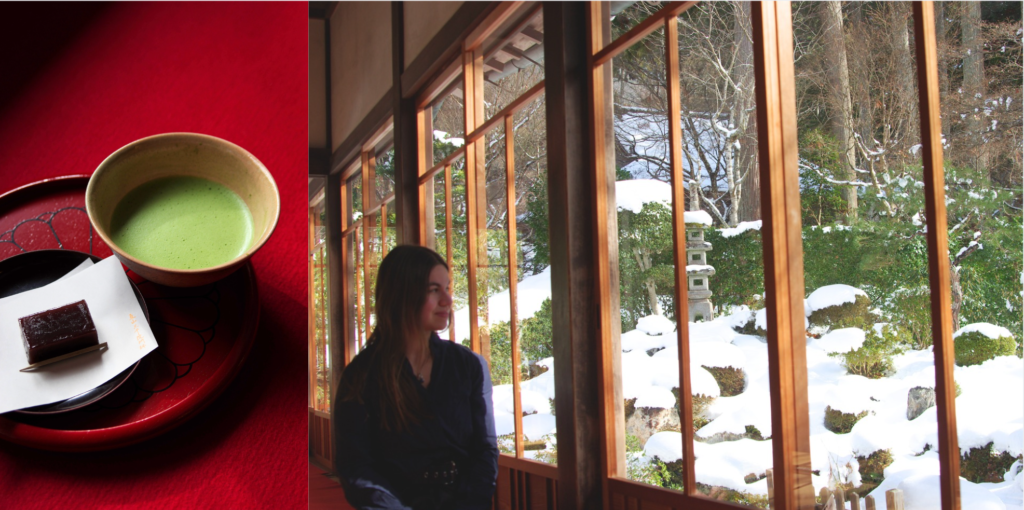
On the left, a delicate and traditional tea set with vibrant green matcha and a piece of yokan. On the right, a young woman sits inside a wooden temple corridor, gazing out at a peaceful snow-covered garden with stone lanterns and carefully pruned greenery.
When and Where to Experience the Festival
The Hatsu Uma Daikondaki Festival is held annually in early to mid-February, with the exact date determined by the lunar calendar. Sanzen-in Temple, in 2025 it was from 8th to 11th of February.
The heart of this event, is located in Ohara, a rural district just north of Kyoto. While it remains a bit off the beaten path compared to Kyoto’s more tourist-heavy sites, its tranquil beauty and historical depth make it a hidden gem worth the journey.
While the Daikon (radish bowl) is free, the general to the admission to the temple is 700 yen for adults. Since Sanzen-in is a well-maintained temple with stunning moss gardens, tea houses and breathtaking seasonal scenery, many visitors choose to explore the grounds before or after experiencing the festival.
Why You Should Witness This Unique Festival
Beyond the serene beauty of a snow-covered Sanzen-in Temple and the simple pleasure of warm daikon, the Hatsu Uma Daikondaki Festival is a window into Japan’s rich tapestry of spiritual and cultural traditions. It’s a reminder that festivals are not just spectacles but living rituals that continue to connect people to their past and future. For travelers looking to experience a festival that remains largely untouched by mass tourism, this is a rare opportunity to step into a quieter, more contemplative side of Japan.
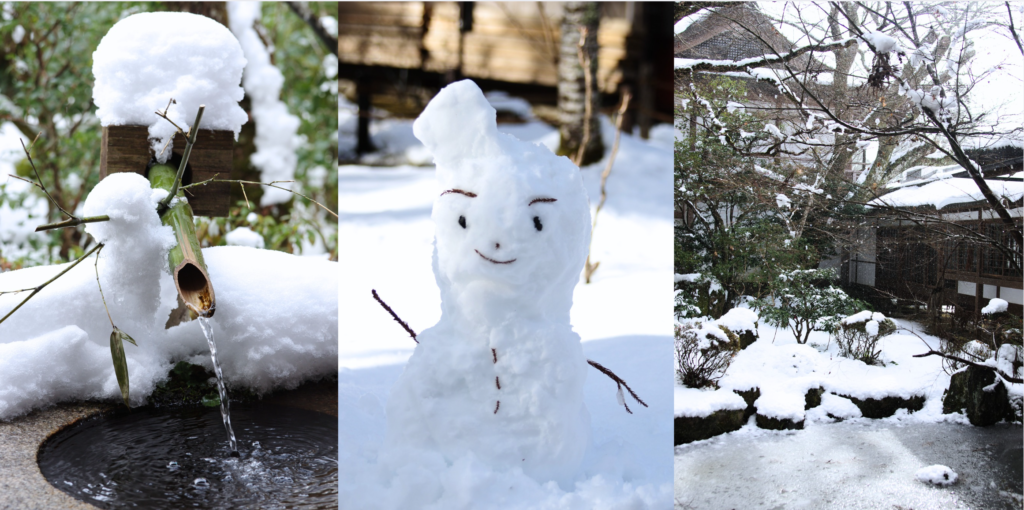
From left to right: Aa traditional bamboo water spout covered in snow, a small, handmade snowman with twig arms and a smiling face and the peaceful Japanese garden from Sanzen-in blanketed in fresh snow.
Whether you seek luck for the year ahead, wish to experience the peaceful atmosphere of a snow-cloaked temple, or simply want to witness one of Kyoto’s most intimate seasonal festivals, the Hatsu Uma Daikondaki Festival offers an unforgettable journey—one that lingers in memory like the crisp winter air and the warmth of daikon on a cold day.
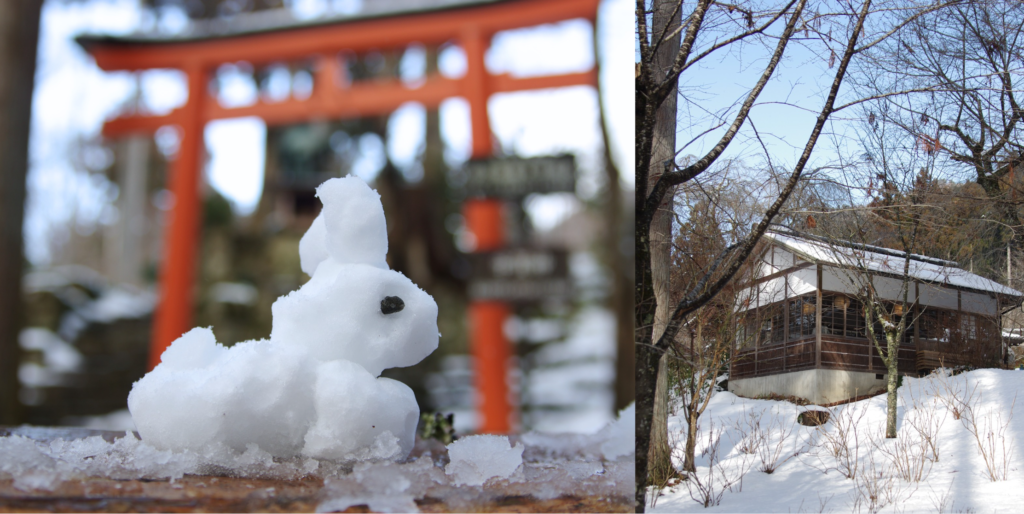
Sanzen-in Temple: A small snow rabbit figurine sits on a wooden surface with a blurred red torii gate in the background, symbolizing a peaceful winter scene in Japan. On the right, a traditional Japanese house serving salty tea stands in a snow-covered landscape with bare tree branches reaching toward the sky.
How to Get to Sanzen-in Temple from Kyoto and Osaka
From Kyoto: Take the Kyoto City Bus (number 17 or 19) from Kyoto Station to Ohara (about 1 hour). From the Ohara bus stop, it’s a 10-15 minute scenic walk through the village, where you’ll find shops selling local delicacies like shiso (perilla leaf) products and handmade crafts.
From Osaka: Take the JR Tokaido-Sanyo Line to Kyoto Station, then follow the same bus route to Ohara. Alternatively, take the Keihan Main Line from Osaka to Demachiyanagi Station, then transfer to a bus to Ohara (total travel time: approximately 90 minutes).

Two special snowmen on the way from Sanzen-in back to the station: On the left with button decorations and a red mouth, on the right: a snowfrog with an arched entrance, both sitting in a snowy area under bright sunlight. A sign in the background reads “Ōhara Onna no Komichi,” 12 minutes walking distance to the Sanzen-in Temple near Kyoto.
Copyright Notice
All images are the property of photographer Leyla Ozkan. Unauthorized use, reproduction or distribution of these photographs without explicit permission is strictly prohibited. If you wish to use any of these images, please contact the photographer via Instagram (@leyla.clicks) to request permission.
Any unauthorized use will be subject to legal action under copyright law.